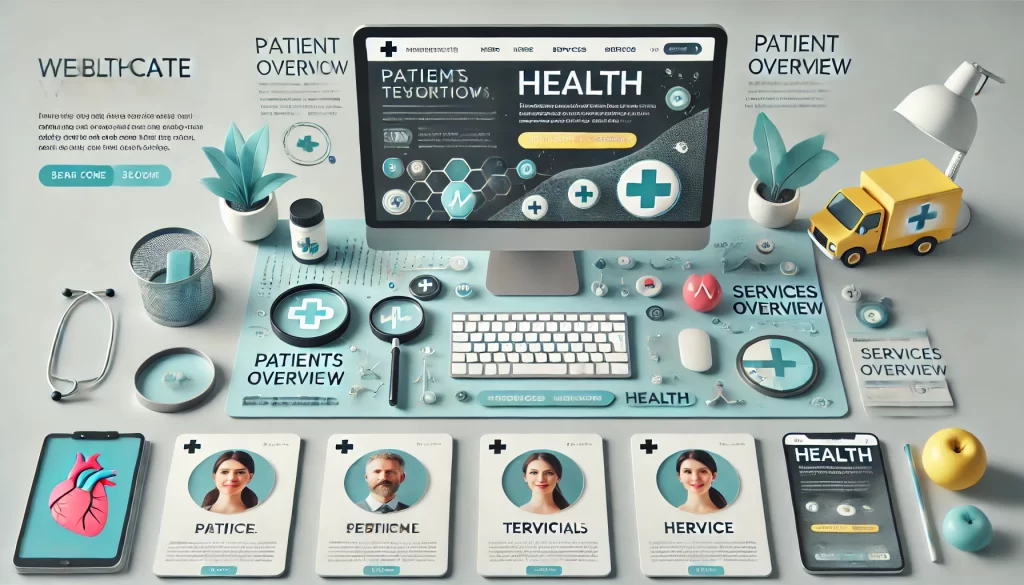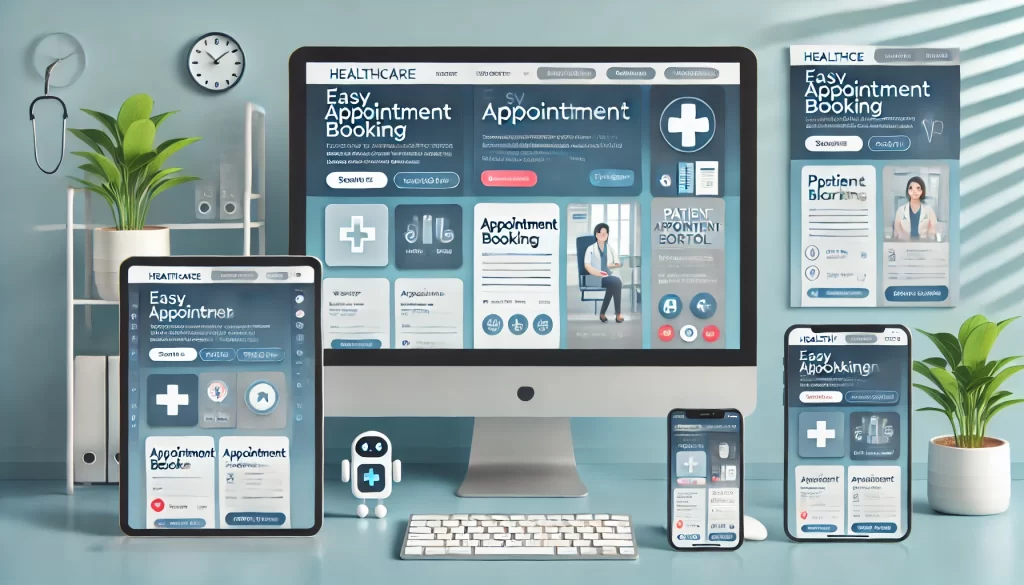Introduction
In today’s digital age, healthcare websites are no longer just a necessity—they are vital tools for connecting healthcare providers with patients, clients, and users. Whether you’re a doctor, wellness coach, holistic health practitioner, or part of a larger healthcare organization, your website must cater to the needs of your visitors while projecting authority, trustworthiness, and professionalism. A well-designed healthcare website has the power to inform, engage, and convert visitors into loyal clients or patients. But what makes an effective healthcare website?
This article will explore the key elements of effective healthcare websites, focusing on essential aspects such as user experience (UX), conversion optimization, SEO best practices, and visual design. We’ll dive deep into the features that make healthcare websites stand out and establish trust with potential patients and clients. Additionally, we’ll discuss real-world examples and best practices to help you craft a website that aligns with your goals.

Related Posts
- Case Studies of Top Healthcare Websites
- Integrating Wellness Services
- Social Media Strategies for Holistic Health Websites
User Experience (UX)
How to Build Easy-to-Use Healthcare Websites
When it comes to healthcare website design, user experience (UX) is paramount. For healthcare websites to be effective, visitors must easily find the information they need without frustration. Simple, intuitive navigation is a key feature of any well-designed site.
For example, websites for general healthcare providers—such as hospitals, doctors’ offices, and wellness centers should feature clear and logical categories that allow users to navigate to pages like services, team members, appointments, and patient resources. Avoiding cluttered menus and ensuring the structure is logical will make the site user-friendly.
In healthcare, it’s essential to prioritize clarity over complexity. A simple navigation menu ensures users can quickly find what they need without sifting through layers of irrelevant information.
Mobile Responsiveness and Fast Load Times
In today’s world, many users access healthcare websites from mobile devices. As such, mobile responsiveness is a critical element of healthcare websites. The layout, fonts, and buttons should adapt seamlessly to smartphones and tablets, providing a smooth and easy experience for mobile visitors.
Additionally, website speed plays a vital role in user experience. Slow-loading pages can frustrate users, leading to higher bounce rates and lower conversions. Healthcare websites should be optimized for fast load times, ensuring a smooth browsing experience for visitors regardless of their device or internet connection.

Conversion Optimization
Call-to-Action (CTA) Strategies: Best Practices for Healthcare Websites
The ultimate goal of a healthcare website is often to convert visitors into patients, clients, or customers. A website with great content and beautiful design will fall short without conversion optimization. One of the most effective strategies for increasing conversions is through clear and compelling calls to action (CTAs).
For example, healthcare websites can feature CTAs that lead users to:
- Book appointments
- Sign up for courses or workshops
- Contact the healthcare provider
- Subscribe to newsletters
A well-crafted CTA not only encourages action but also assures users that they are making the right decision. Phrases like “Book Your Appointment Today” or “Start Your Wellness Journey” add a personal touch and instill a sense of urgency.
Booking Appointments, Course Sign-ups, and Contact Forms
For healthcare professionals and organizations, booking appointments or course sign-ups are essential components of the website. A simple online booking system is an important feature that allows patients or clients to schedule appointments quickly and easily. This tool should integrate with the provider’s calendar to avoid double bookings and ensure real-time availability.
In addition to appointment booking, contact forms are essential for encouraging user engagement. These forms should be easily accessible and user-friendly. Remember, visitors appreciate a straightforward, hassle-free process when contacting a healthcare provider.
SEO Best Practices for Healthcare Websites
Keywords for Healthcare Professionals
Search Engine Optimization (SEO) is one of the most powerful ways to increase traffic to your healthcare website. To ensure that potential patients or clients find your website, it’s essential to incorporate targeted healthcare keywords throughout your site. For example:
- “Healthcare websites” and “healthcare platforms examples” can be included in your content, headers, and meta descriptions.
- If you’re running a holistic health website, targeting keywords like “natural health websites” and “wellness sites” can help increase organic search traffic from people interested in alternative therapies.
Understanding which keywords your target audience is using to find healthcare services is essential to increasing your site’s visibility. Tools like Google Keyword Planner and SEMrush can provide insights into the most relevant keywords in your niche.
Content Structure for Healthcare Websites
A well-structured healthcare website isn’t just easy to navigate—it’s also SEO-friendly. Healthcare websites should focus on clear and organized content, with headings and subheadings that are rich in keywords. The use of H1, H2, and H3 tags to structure content allows search engines to understand your website’s hierarchy, helping it rank better.
For example, natural health websites might feature blog posts on herbal remedies, alternative medicine, or wellness tips, all using relevant keywords and well-structured headings. This will make the content more discoverable and useful to users seeking information on natural health.
Visual Design & Branding
Color Schemes for Wellness and Trust
The visual design of your healthcare website plays a significant role in building trust and communicating your brand’s values. Color schemes can influence user perceptions and emotions, making it essential to choose colors carefully.
For wellness and healthcare websites, colors like green, blue, and white are often associated with health, tranquility, and trust. These colors evoke a sense of calmness and safety—two qualities that are essential for healthcare providers. Holistic health websites often use earthy tones, such as soft browns, greens, and pastel colors, to promote a sense of natural wellness.
Branding and Imagery
Healthcare websites must also feature high-quality images that align with their branding. Whether you’re designing a website for a medical practice or a wellness center, using real photos of staff, patients, or clients helps to humanize the brand and create a connection with visitors. Avoid using overly generic stock photos that might come off as disingenuous or impersonal.
Imagery should complement your color scheme and overall branding, creating a cohesive look and feel across all pages. From healthcare service pages to patient testimonials, imagery should help tell a story about the care and services you provide.
FAQs
What are the key features of effective healthcare website design?
Effective healthcare websites prioritize user experience with easy navigation, mobile responsiveness, fast load times, and conversion optimization (clear CTAs). They also follow SEO best practices and use trustworthy branding.
How can I improve my healthcare website’s user experience?
Focus on simple, intuitive navigation, ensure the site is mobile-friendly, and make sure your contact forms and appointment booking systems are easy to use.
What should be included in a healthcare website to drive conversions?
Include clear CTAs for scheduling appointments, signing up for newsletters, and contacting the provider. An easy-to-use online booking system can also increase conversions.
How can SEO improve my healthcare website’s visibility?
By using targeted healthcare keywords, optimizing content structure, and following SEO best practices, you can increase your website’s visibility and attract more visitors.
Key Takeaways
Building an effective healthcare website involves a strategic approach to user experience (UX), conversion optimization, SEO, and visual design. By focusing on these elements, healthcare providers can ensure their website is accessible, trustworthy, and capable of converting visitors into patients or clients. Remember, your healthcare website is often the first point of contact with potential patients make sure it’s designed to engage, inform, and convert.
- User experience is essential for retaining visitors. Simple navigation, mobile responsiveness, and fast load times are key.
- Conversion optimization through clear CTAs and easy appointment booking is crucial for healthcare websites.
- SEO best practices, including keyword optimization and content structure, help improve site visibility.
Visual design elements like color schemes and imagery play an important role in conveying trust and professionalism.
